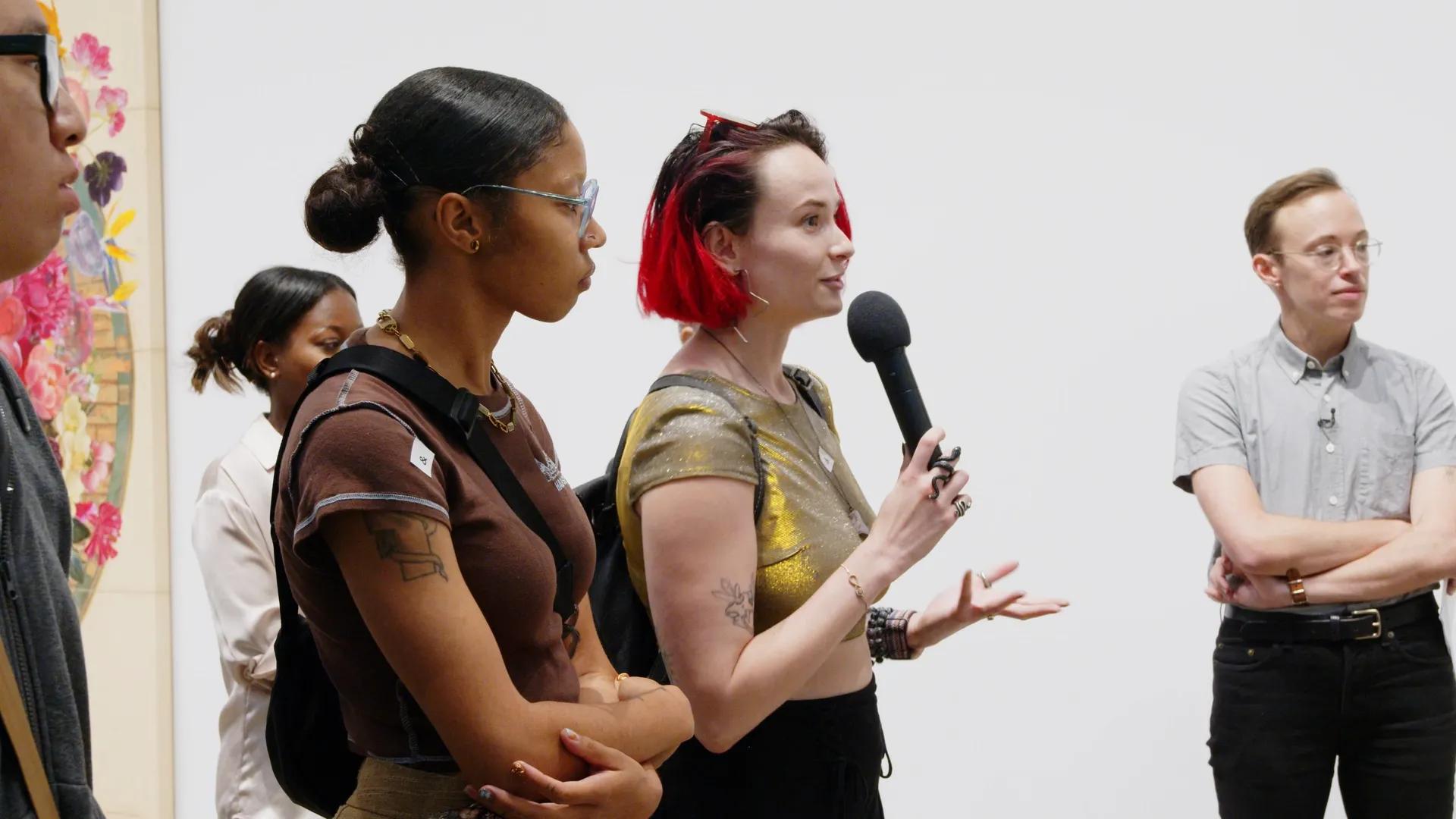
Image courtesy Laure Prouvost and Grizedale Arts
The Land We Live In – The Land We Left Behind
This resource has been produced to accompany the exhibition ‘The Land We Live In – The Land We Left Behind’ at Hauser & Wirth Somerset.
About the exhibition
‘The Land We Live In – The Land We Left Behind’ has been curated by Adam Sutherland. It is a survey exhibition, which explores the contradictory nature of society’s relationship to the rural. The show includes over 50 international artists and creatives, as well as works on loan, by artists working from the 1500s to the present day, including Paul McCarthy, Beatrix Potter, Carsten Höller, Laure Prouvost, William Holman Hunt, Samuel Palmer, Frank Lloyd Wright, Marcus Coates, Fernando García-Dory, Mark Dion, Roni Horn, Aaron Angell and Mark Wallinger.
The exhibition tells the story of humanity’s evolving connection to the land, our perception of, and reliance upon it. Viewers will have the opportunity to engage with the themes of the exhibition through a series of participatory artists’ projects and practical presentations, such as aquaponics, fermentation, goat milking and cheese making.
What is the theme of this exhibition?
The exhibition’s title refers to a toast used by migrants in the 18th and 19th centuries, which celebrated the land they had arrived in, followed by a riposte celebrating their country of origin – a place that for many embodied romantic longing. The selected works suggest the rural as a laboratory for the development of ideas, in particular the notion of a rural utopia, exploring the religious migrants, the industrial escapees, the metaphors of the flight from Egypt and the return to Eden, that are embedded in humanity’s collective unconscious. This vision is counter-balanced and punctuated by pieces of documentary and reportage, from works illustrating the reality of modern farming, to artefacts relating to boy racers’ car culture. The exhibition draws together visual material to represent themes such as territorial politics and natural instinct, against the backdrop of a harmonious natural landscape.
Arts and Crafts Movement
The Arts and Crafts Movement was an English decorative arts movement of the second half of the 19th Century which sought to revive the ideal of craftsmanship in an age of increasing mechanisation and mass production.
Key Artists: C.R Ashbee, William Morris, and John Ruskin.
Pre-Raphaelites
Inspired by the theories of John Ruskin, who urged artists to ‘go to nature’, they believed in an art of serious subjects treated with maximum realism. Their principal themes were initially religious, but they also used subjects from literature and poetry, particularly those dealing with love and death. They also explored modern social problems.
Key Artists: William Holman Hunt, and Edward Burne-Jones.
Socially Engaged Practice
Socially engaged practice, also referred to as social practice or socially engaged art, can include any art form which involves people and communities in debate, collaboration or social interaction.
Key Artists: Somewhere (Karen Guthrie), Jeremy Deller and Alan Kane, Public Works, Mark Wallinger, and Grayson Perry.
Landscape
All the visible features of an area of land, often considered in terms of their aesthetic appeal. Landscape is a traditional genre in Western art and today landscape continues to be a major theme in art with many artists using documentary techniques such as video and photography.
Key Artists: Don McCullin, Samuel Palmer, Paul Nash, John Martin, David Jones, William Blake, and Anj Smith.
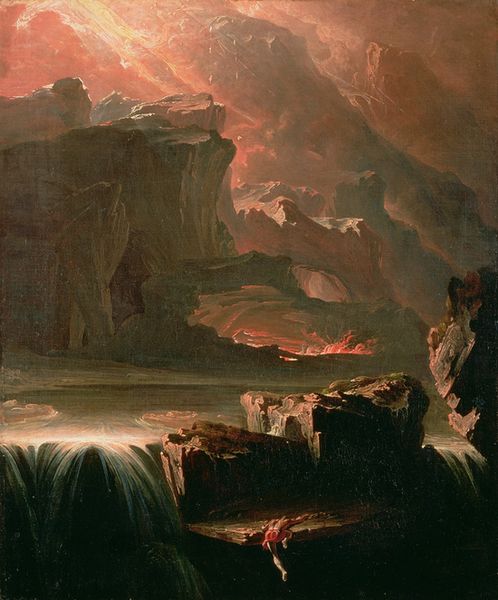
John Martin (1789-1854), Sadak in Search of the Waters of Oblivion, 1812, Oil on canvas. Courtesy of Southampton City Art Gallery, Hampshire, UK / Bridgeman Images
Natural Forms
The traditional genre of still life painting or drawing often depicts natural subject matter such as food, flowers, dead animals, plants or rocks etc. Contemporary artists may respond to this genre in formats other than painting or drawing.
Key Artists: Giuseppi Arcimboldo, Carsten Höller, Beatrix Potter, Jacob Van Hulsdonsk, and Kate Greenaway.
Performance
Artworks that are created through actions performed by the artist or other participants are often referred to as performance art. These may be live or recorded, spontaneous or scripted.
Key artists: Bedwyr Williams, Marcus Coates, Allan Kaprow, Fernando García-Dory, and Paul McCarthy.
Farming and Food
The exhibition features displays on growing and processing produce; farming, food and the way we eat have become significant themes in contemporary artists’ work revisiting traditional connections and a broader notion of creativity.
Key Artists: Karen Guthrie, Pablo Bronstein, Aaron Angell and Tom Philipson.
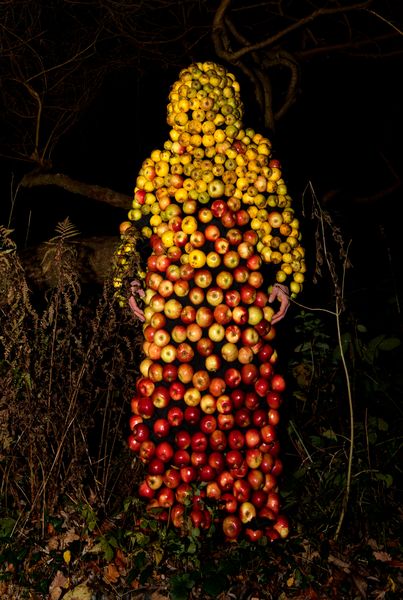
Marcus Coates, Apple Service Provider, 2017. Photo: Andy Gott © Marcus Coates
Rural
In opposition to urban living and modernity, as a theme the rural landscape represents ideas associated with tradition, nature, agriculture and romance. Many social movements have attempted to create rural utopias, from the Adamites to William Morris. This exhibition also looks at the influence of the rural on urban culture, from art to public realm design to marketing.
Key Artists: William Morris, Frank Lloyd Wright, and Piet Oudolf.
High and Low Culture
Since the 20th century there have been many debates about high art and low art and these have developed as part of wider cultural distinctions. Low art is often considered to be cultural forms that are understood by the average person or the masses, such as TV or magazines. High art is considered to hold some sort of special importance, that means it is understood by only those educated or an elite group. Low art that takes on the ideas of high art is often referred to as kitsch.
Some of the artists in the exhibition make work that comments on this, some of the art is low art and some of the objects are kitsch because of the way in which they are displayed, for example a painting by Kurt Schwitters is high art; the Lilliput Lane ceramic house is low art.
Key artists: Olaf Breunning, Denis Constandurors, and Grayson Perry.
Collectives
Loosely defined, an art collective is a group of artists working together to achieve a common objective. The collectives featured in this show are interdisciplinary and concerned with ways of living and with finding inspiration in the culture of the rural.
Key Artists: Mildred’s Lane, myvillages, Somewhere, Kultivator, Fairland Collective, and Phytology.
How is the exhibition displayed?
The exhibition takes place in all five galleries as well as the Farmyard and Cloisters. The curator has selected not only art works but objects, ephemera and archival material which is presented in each space and provides a different theme and atmosphere as you walk through the spaces as described below.
Farmyard
Upon arriving at Hauser & Wirth Somerset viewers may encounter goats grazing in the grass farmyard; artist Fernando García-Dory and Hayatsu Architects have created a wooden pavilion – a functioning artwork – for goats to climb on and socialise. You will not see the goats everyday; milking and cheese making workshops have been scheduled as part of the gallery’s event programme, please visit the website for details.
Threshing Barn Use, Produce, Growing and Processing
In a fitting tribute to its original usage, the Threshing Barn features a display on growing and processing produce. This highlights a move by an increasing number of artists and creative people to involve themselves in making things that are part of, and useful to, communities. This social agenda often draws on the basic building blocks of the rural; of growing and production. All of the projects referenced are examples of systems that supply, with most of the installations generating food: fish, eggs, cheese and salad.
Works include a tiered aquaponic tank system by Sweet Water Foundation, a Chicago based community renewal project using the miracle of growth as a political and symbolic tool; Erik Sjödin’s Azolla pond weed project; Carsten Höller’s ‘Giant Triple Mushrooms’; and Tom Philipson’s ‘Egg Rack Calendar’. A mobile cheese production unit and an associated Goat Pavilion designed by Hayatsu Architects (visible through the barn doors) are both works by Fernando García-Dory, and are the basis of his well-established School for Shepherds. In the Cloister Courtyard is Hayatsu Architects’ ‘Community Bread Oven’, a working oven built in collaboration with architecture students from Central Saint Martins that was created for the village of Coniston in the Lake District.
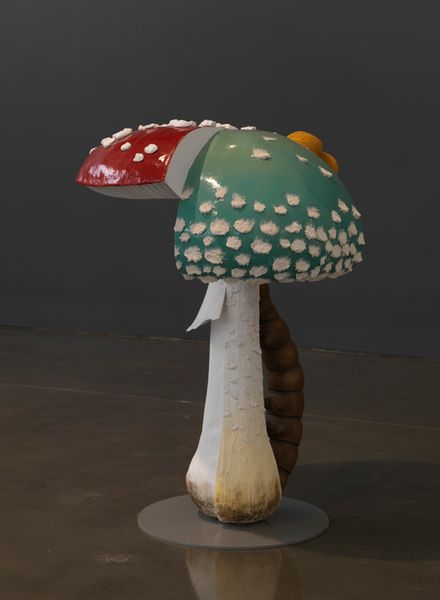
Carsten Höller, ‘Giant Triple Mushroom’, 2015. © Carsten Höller
Workshop Gallery and Pigsty Gallery Rural Revolutionaries
Many social movements have attempted to create rural utopias, from the Adamites, Diggers and New (Californian) Diggers, to William Morris and interrelated visionary communities. These spaces house a mix of historic works and artefacts, interspersed by relevant contemporary works that form a visual essay, following some of these aesthetically rich and ideologically disparate attempts, and highlighting how our interaction with the rural has evolved, but not really changed.
The first section illustrates a few of the many social movements motivated by religious ideologies, whilst the second room references to those where the principle driver has become political – the Arts & Crafts movement perhaps being one of the clearest examples. All were driven by a desire to escape and reimagine a ‘Return to Eden’. Amongst the many works on display are included William Holman Hunt’s ‘Afterglow in Egypt’ (c. 1854 – 63), a William Heath Robinson cartoon ‘Tightening up the Green Belt’ (c. 1935 – 47) and a pair of sandals (c. 1890) belonging to the radical Victorian writer and philosopher Edward Carpenter. The collection is connected by a series of interpretative wall drawings by Fernando García-Dory.
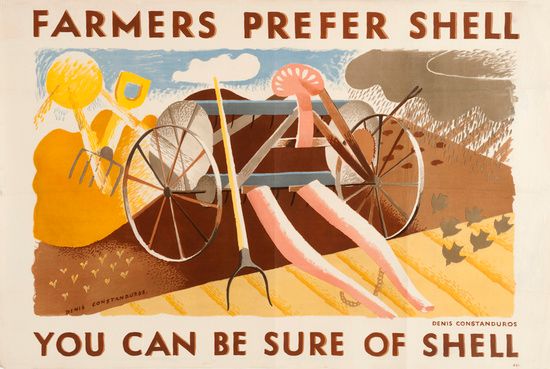
Denis Constanduros, Farmers Prefer Shell, 1934. Courtesy of Shell Heritage Art Collection
Rhoades Galllery Revival, Resurrection and Transformation
The works in this room reflect on the idea of transformation, transition, and transubstantiation, and allude to the elemental and ritualistic nature of those processes.
On the far wall, Nikolaus Geyrhalter’s film ‘Our Daily Bread’ (2005) lyrically depicts the highly- developed technologies of contemporary farming. Dominating the centre of the room is a series of long tables with works relating to social eating, by various artists and collectives including Bedwyr Williams, Laure Prouvost, Pablo Bronstein, Aaron Angell and Francesca Ulivi. Food and eating have become significant themes in contemporary artists’ work, revisiting traditional connections and a broader notion of creativity.
The remainder of the room is populated by two small structures, one of which is ‘Anchorhold’ (2015) designed by the architectural practice Sutherland Hussey Harris, working in collaboration with artist Marcus Coates. The name ‘Anchorhold’ refers to a 10th century hermitage in which Anchorites would withdraw from society to deliberate on God. The stored apples are available for visitors to eat. The second structure is the ‘House of Ferment’ (2015) by Karen Guthrie, a mobile larder that includes collected vintage kitchenalia and functional components by invited artists.
A compost heap is installed in the far section of the gallery to symbolise growth and transformation, the biological action of death into life; soil being one of the essential components for sustaining life, alongside water, light and air. Displayed on the walls nearby are four iconic works from 1572 by Giuseppe Arcimboldo, humorously celebrating our connection with nature and the seasons. These are joined by a magnificent Flemish still life painting of a banquet-piece, by Jacob van Hulsdonck and a John Martin painting, ‘Sadak in Search of the Waters of Oblivion’ (1812), which depicts a tiny climbing figure set against a vast and unstable landscape – a timeless motif of human endeavour and the force of nature.
Lobby Area
A lobby leading off from this gallery houses The Honest Shop, selling products handmade by the local community. There is no special selection process for what is sold; anyone living locally may place their wares in the shop – provided they are handmade. Visitors may purchase the products at the price specified and are trusted to leave the money in an honesty box. This bespoke, unregulated model for trading provides a unique snapshot of the people of Bruton and suggests an alternative to commercial mass consumerism.
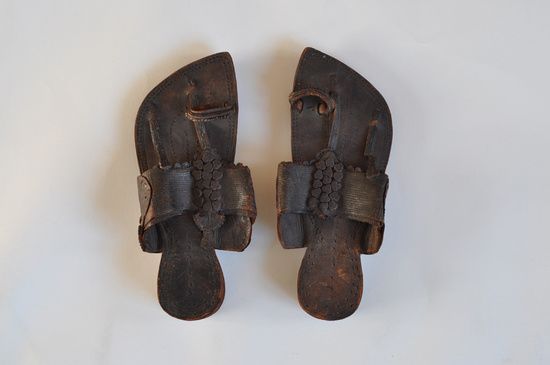
Edward Carpenter, Leather Sandals, C. 1890, Dimensions Variable. Courtesy of Sheffield City Archives
Bourgeois Gallery The Urban Ruralist
This final room in the exhibition examines the influence of the rural on urban culture, from art to public realm, design to marketing. It includes contributions from many interdisciplinary collectives, among them Mildred’s Lane, myvillages, Somewhere, Kultivator, Fairland Collective and Phytology. All are concerned with ways of living, with finding inspiration in the culture of the rural, and in the cycle of the seasons. These impulses are transformed into societal function and benefit.
What is a curator?
Today, the role of the curator has developed significantly. Not only can it mean to preserve and look after art with an awareness of art history but to select and interpret new work. Curators display and arrange the artwork, and in recent times this means being responsible for creating an experience: something educational, meaningful, aesthetic and spectacular. The name of the curator for this exhibition is Adam Sutherland.
About Adam Sutherland
Adam Sutherland is Director of Grizedale Arts, an arts collective based on a farm in the Lake District of England. As the director he leads many of the projects, creating structures into which a wide range of people can contribute, from artists to farmers, fishermen to philosophers. Since taking on the role in 2000, Adam Sutherland has overseen three incarnations of the project (Socially Engaged Sculpture Park, Useful Communities Programme and International Small Place). Standout art world projects include ‘Romantic Detachment’ for PS1, ‘Coliseum of the Consumed’ for Frieze Projects, ‘A Fair Land’ for the Irish Museum of Modern Art, ‘7 Samurai’ for the Echigo-Tsumari Art Triennial, Japan and ‘The Benevolent Order for the Repurposing of Public Artworks’ for APAP Korea. Sutherland is currently enthused by thoughts of a Confederacy of Villages, A Register of Intangible National Assets and establishing an internationally connected craft valley and residency farm in Japan. www. grizedale.org
Additional Research
Grizedale Arts at grizedale.org Hauser & Wirth artists at hauserwirth.com
Glossary
Acquaponics
Refers to any system that combines conventional aquaculture (raising aquatic animals such as snails, fish, crayfish or prawns in tanks) with hydroponics (cultivating plants in water) in a symbiotic environment.
Anchorites
Someone who lives alone and away from other people for religious reasons. The anchoritic life is one of the earliest forms of Christian monasticism.
Arcadian
Refers to Arcadia the region of Greece or its inhabitants, known as those living in harmony with nature; a person who leads or prefers a quiet simple rural life.
Diggers
A group of Protestant radicals in England. Sometimes seen as forerunners of modern anarchism they became known as Diggers because of their attempts to farm on common land.
Fermentation
A metabolic process that consumes sugar in the absence of oxygen. The products are organic acids, gases, or alcohol.
Fordism
Fordism is the basis of modern economic and social systems in industrialised, standardised mass production and mass consumption. The concept is named after Henry Ford, the founder of Ford Motor Company.
Ideology
Describes the set of beliefs, conscious and unconscious ideas, that an individual, group or society has.
Protagonist
The leading character, or champion of a particular cause or idea.
Ruralist
Someone who lives in a rural location or argues for the rural.
Shamanism
Shamanism is a practice that involves a practitioner reaching altered states of consciousness in order to perceive and interact with a spirit world and channel these transcendental energies into this world.
Transubstantiation
A belief of the Roman Catholic Church who teach that once an ordained priest blesses the bread of the Lord’s Supper, it is transformed into the actual flesh of Christ (though it retains the appearance, odor, and taste of bread); and when he blesses the wine, it is transformed into the actual blood of Christ (though it retains the appearance, odour, and taste of wine).
Urban Ruralist
A city dweller who adopts certain practices and aesthetics that they perceive to be associated traditional rural ideals.
Utopian
A desired environment or state where everything is perfect.
Resources
1 / 8




